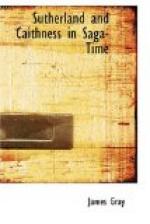Save in north-east Ness, and in favoured spots elsewhere, also below the 500 feet level, the land of Cat was a land of heath and woods[3] and rocks, studded, especially in the west, with lochs abounding in trout, a vast area of rolling moors, intersected by spacious straths, each with its salmon river, a land of solitary silences, where red deer and elk abounded, and in which the wild boar and wolf ranged freely, the last wolf being killed in Glen Loth within twelve miles of Dunrobin at a date between 1690 and 1700.[4] No race of hunters or fishermen ever surpassed the Picts in their craft as such.
The land, especially Sutherland, is still a happy hunting-ground not only for the sportsman but also for the antiquary. For the modern County of Sutherland is outwardly much the same now as it was in Pictish times, save for road and rail, two castles, and a sprinkling of shooting lodges, inns, and good cottages, which, however, in so vast a territory are, as the Irishman put it, “mere fleabites on the ocean.” Much of the west of the land of Cat was scarcely inhabited at all in Pictish or Viking days, because as is clearly the case in the Kerrow-Garrow or Rough Quarter of Eddrachilles, it would not carry one sheep or feed one human being per hundred acres in many parts. The rest of it also remains practically unchanged in appearance from the earliest days till the present time, as it has been little disturbed by the plough save in the north-east of Ness and at Lairg and Kinbrace, and in its lower levels along the coast. But Loch Fleet no longer reaches to Pittentrail, and the crooked bay at Crakaig has been drained and the Water of Loth sent straight to the sea.
The only buildings or structures existing in Cat in Pictish and early Norse times were a few vitrified forts, some underground erde-houses, hut-circles innumerable, and perhaps a hundred and fifty brochs, or Pictish towers as they are popularly called, which had been erected at various dates from the first century onwards, long before the advent of the Norse Vikings is on record, as defences against wolves and raiders both by land and sea, and especially by sea. Notwithstanding agricultural operations, foundations of 145 brochs can still be traced in Ness and 67 in Strathnavern and Sudrland, but they were not all in use at the same time, and they are mostly on sites taken over later on by the Norse,[5] because they were already cultivated and agriculturally the best.
A well-known authority on such subjects, the late Dr. Munro, in his Prehistoric Scotland p. 389 writes of the brochs as follows:—“Some four hundred might have been seen conspicuously dotting the more fertile lands along the shores and straths of the counties of Caithness, Sutherland, Ross, Inverness, Argyll, the islands of Orkney, Shetland, Bute, and some of the Hebrides. Two are found in Forfarshire, and one each in the counties of Perth, Stirling, Midlothian, Selkirk and Berwick.”




